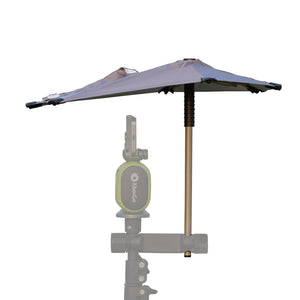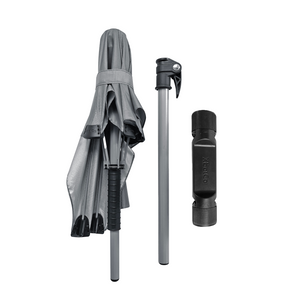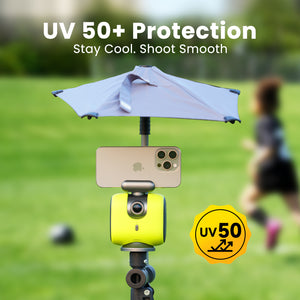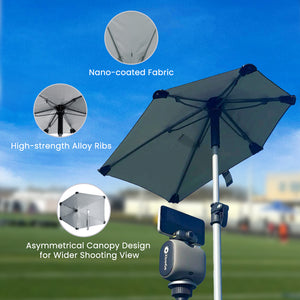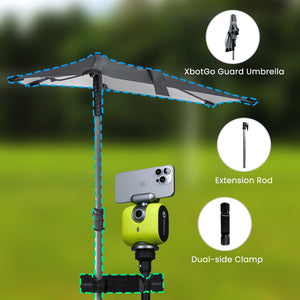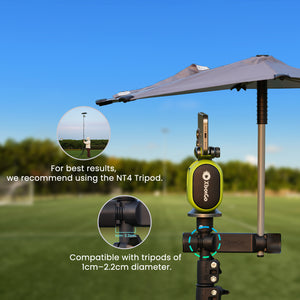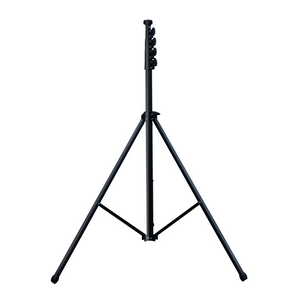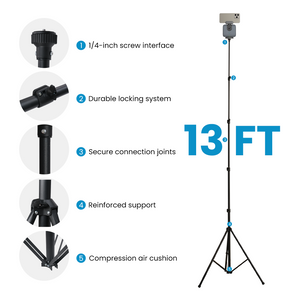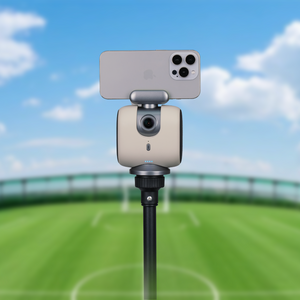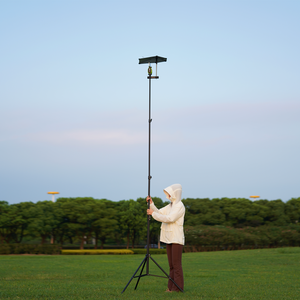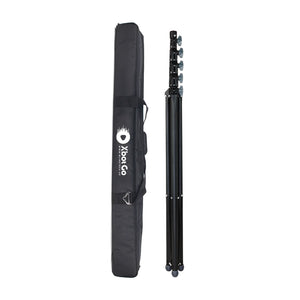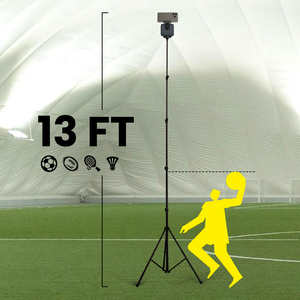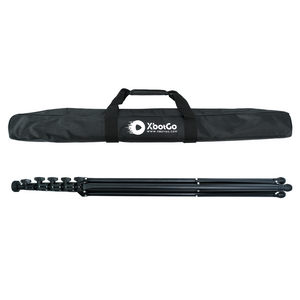XbotGo Chameleon AI Sports Camera
Posiciones de hockey: todo lo que necesitas saber
Estás en la pista para tu primer partido de hockey, con el corazón acelerado por la emoción, pero de repente te invade la confusión. ¿Dónde deberías estar exactamente? ¿Cuál se supone que es tu rol? Si alguna vez te has sentido perdido intentando entender las posiciones del hockey, no estás solo.
En esta guía completa, desglosaremos cada posición de hockey de forma clara y práctica. Descubrirás no solo qué hace cada posición, sino también cómo aprender y mejorar en ellas. Abordaremos los verdaderos desafíos que enfrentan los principiantes y ofreceremos métodos probados que funcionan en todos los niveles.
Entendiendo el sistema de 6 jugadores del hockey
Los equipos de hockey ponen a seis jugadores en la pista a la vez, creando un sistema dinámico donde cada uno desempeña un rol específico, manteniendo la flexibilidad para adaptarse. Esta estructura de seis jugadores incluye tres delanteros, dos defensas y un portero.
La belleza del hockey reside en cómo estas posiciones interactúan. A diferencia de algunos deportes con límites posicionales rígidos, en el hockey las posiciones fluyen y se adaptan según las situaciones del juego. Como señala un jugador experimentado : «Las posiciones son mucho más fluidas en 2022 que antes». Esta fluidez implica que los jugadores deben comprender no solo su posición principal, sino también cómo se relaciona con los roles de sus compañeros.
Imagínatelo como una danza bien coreografiada donde cada jugador conoce su papel, pero puede improvisar cuando es necesario. Los delanteros impulsan el ataque, los defensas protegen la zona defensiva mientras apoyan las embestidas, y el portero sirve como última línea de defensa. Juntos, forman un equipo completo donde el éxito depende de que todos comprendan y cumplan con sus responsabilidades.
Posiciones avanzadas: el motor ofensivo
Centro: El mariscal de campo creador de jugadas
La posición de centro destaca como quizás la más exigente y versátil del hockey. A menudo llamados el "mariscal de campo" del equipo, los centros controlan el ritmo del juego y asumen las mayores responsabilidades en ambos sentidos.
Los centros se encargan de la mayoría de los saques de centro, esas cruciales caídas de disco que reinician el juego. Ganar estos saques de centro significa obtener la posesión inmediata, una ventaja clave en el hockey. Pero su rol va mucho más allá del círculo de saques de centro. Los centros deben poseer habilidades excepcionales de pase, ya que son responsables de crear oportunidades de gol para sus extremos. Necesitan lo que los entrenadores llaman "coeficiente intelectual del hockey": la capacidad de leer las jugadas antes de que se desarrollen y posicionarse en consecuencia.
Connor McDavid ejemplifica el rol del centro moderno. Su combinación de velocidad, visión y compromiso bidireccional demuestra por qué los centros necesitan una resistencia de élite. Están en constante movimiento, apoyando jugadas defensivas en un momento y liderando acometidas ofensivas en el siguiente. Como lo describe un jugador : "Jugarás con el disco. Cuando no lo tengas, estarás encima intentando recuperarlo".
En la zona defensiva, los centros tienen la mayor cobertura, protegiendo lo que los jugadores llaman "la casa", la zona crítica frente a su portería. Deben retroceder rápidamente durante los ataques rivales y luego pasar al ataque inmediatamente cuando su equipo recupera la posesión.
Extremos: Los especialistas en marcar goles
Los extremos izquierdo y derecho aportan velocidad y capacidad de definición a la delantera. Estas posiciones suelen atraer a los patinadores más rápidos, que combinan potencia ofensiva con posicionamiento estratégico en sus respectivos lados de la pista.
¿La misión principal de los extremos? Marcar goles y crear ocasiones de gol. Trabajan en los rebotes en la zona ofensiva, luchan por el disco en las esquinas y se posicionan para tiros cortos y desvíos. Nikita Kucherov y David Pastrnak representan el prototipo de extremo de élite: tiradores letales que también pueden crear jugadas para sus compañeros.
Pero los extremos modernos hacen más que solo anotar. Tienen importantes responsabilidades defensivas, en particular cubriendo a los defensas rivales. Cuando el disco entra en su zona defensiva, los extremos deben resistir la tentación de perseguirlo a ras de suelo, manteniendo su posición para evitar tiros desde el punto y pases largos.
Uno de los errores más comunes que cometen los extremos principiantes es el posicionamiento de salida. Muchos jugadores nuevos se encuentran "deslizando cerca de la línea azul cuando recibimos el disco, sin mucho impulso". ¿La solución? Aprender a retroceder a la zona para ganar velocidad antes de recibir pases de salida, en lugar de quedarse quietos en la línea azul.
Para los principiantes, las posiciones de extremo ofrecen un punto de partida ideal. Ofrecen un equilibrio entre la emoción ofensiva y las responsabilidades defensivas manejables. Como confirman varios jugadores experimentados : «El extremo es, con diferencia, el más fácil y el más indulgente» para quienes están aprendiendo a jugar.
Posiciones defensivas - Los Guardianes de la Línea Azul
Defensores de izquierda y derecha: la columna vertebral defensiva
Los defensas son la columna vertebral de la defensa del equipo, además de aportar un apoyo ofensivo crucial. Estos jugadores deben dominar la que quizás sea la habilidad de patinaje más desafiante del hockey: retroceder a gran velocidad mientras mantienen el control del hueco con los delanteros atacantes.
La responsabilidad principal parece sencilla: prevenir goles. Pero ejecutarla requiere habilidades complejas. Los defensores deben interpretar las jugadas en desarrollo, comunicarse constantemente con su compañero defensivo y tomar decisiones instantáneas sobre cuándo desafiar a los atacantes o proteger las líneas de pase.
En su propia zona, los defensores trabajan en parejas coordinadas. Mientras uno lucha por el disco en la esquina, el otro protege la portería. Esto requiere lo que un jugador llama "una pareja bien ensayada": conocer las tendencias del compañero y adaptarse en consecuencia.
Pero los defensores modernos hacen mucho más que defender. Jugadores como Cale Makar y Quinn Hughes demuestran la evolución del defensa ofensivo. Se lanzan a las carreras, hacen jugadas de poder desde la posición de quarterback y, a veces, lideran a sus equipos en anotaciones. La clave está en saber cuándo activar la ofensiva sin dejar huecos en la defensa.
El "primer pase" representa una habilidad crucial para los defensores. Tras obtener la posesión en su zona, los defensas deben identificar rápidamente la mejor salida: generalmente un extremo que se mueve por el tablero o un centro que se desplaza por el centro. Este pase de transición suele determinar si un equipo genera ataque o se queda atrapado en su propia zona.
El juego físico sigue siendo fundamental en la posición. Los defensas conectan golpes, bloquean tiros y despejan el área. Necesitan fortaleza mental para absorber el impacto y mantener la compostura. Como explica un veterano : «Hay que ser bueno en las jugadas a balón parado, tanto en ataque como en defensa».
Portero - La última línea de defensa
La posición de portero se erige como la más especializada y, posiblemente, la más desafiante del hockey. Si bien todos los demás jugadores comparten fundamentos similares de patinaje y manejo del stick, los porteros se desenvuelven en un mundo único de equipamiento, técnicas y exigencias mentales.
"Mantener el disco fuera de la portería" suena simple, pero ejecutarlo contra tiros a 160 km/h requiere una capacidad atlética y una fortaleza mental extraordinarias. Los porteros se enfrentan a docenas de tiros por partido, cada uno de los cuales representa un gol potencial que podría cambiar el ritmo. Deben seguir el movimiento del disco entre el tráfico, anticipar desvíos y reaccionar al instante a los tiros desde cualquier ángulo.
La portería moderna ha evolucionado significativamente. El estilo mariposa domina el juego actual, con los porteros arrodillándose para cubrir la parte inferior de la portería mientras usan sus guantes y bloqueadores en alto. Pero más allá de la técnica, la posición exige una fortaleza mental única. Como señala un jugador : «Se puede perder con un gran portero, pero no se puede ganar con uno terrible».
Las exigencias físicas son extremas. Los porteros usan entre 18 y 23 kilos de equipo y deben ejecutar movimientos explosivos repetidamente. El ejercicio de acondicionamiento llamado "arriba-abajo" —ponerse en posición de mariposa y recuperarse rápidamente— ejemplifica la exigencia de la posición. Los porteros realizan estos movimientos decenas de veces por partido, manteniendo la concentración y la posición.
La comunicación representa otra habilidad crucial del portero. Desde su posición privilegiada, los porteros ven las jugadas en desarrollo y deben dirigir a sus compañeros. Golpean el palo para señalar el fin de los penaltis, indicar la posición de los jugadores rivales y ayudar a organizar la cobertura defensiva.
Quizás lo más importante es que los porteros deben tener una memoria corta. Tras encajar un gol, no pueden obsesionarse con ello; el siguiente disparo ya está en camino. Jugadores como Andrei Vasilevsky ejemplifican esta resiliencia mental, manteniendo la compostura sin importar el marcador o la situación.
Conclusión
Comprender las posiciones del hockey transforma el caos confuso en una belleza estratégica. Cada posición aporta habilidades y responsabilidades únicas, pero todas se interconectan para crear un juego de equipo exitoso. Los centros orquestan el ataque mientras defienden con responsabilidad. Los extremos aportan velocidad y anotación, manteniendo la atención defensiva. Los defensas protegen su zona mientras contribuyen ofensivamente. Los porteros sirven como la última línea de defensa, dirigiendo el posicionamiento del equipo.
El hielo te espera: elige tu posición y comienza tu aventura. Al fin y al cabo, la mejor manera de aprender a posicionarse en el hockey es salir a jugar. ¡Nos vemos en el hielo!
XbotGo Chameleon AI Sports Camera
Capture every moment with AI-powered tracking. Perfect for coaches, parents, and athletes who want seamless footage without manual filming.







 Soccer
Soccer Basketball
Basketball Ice Hockey
Ice Hockey Rugby
Rugby










